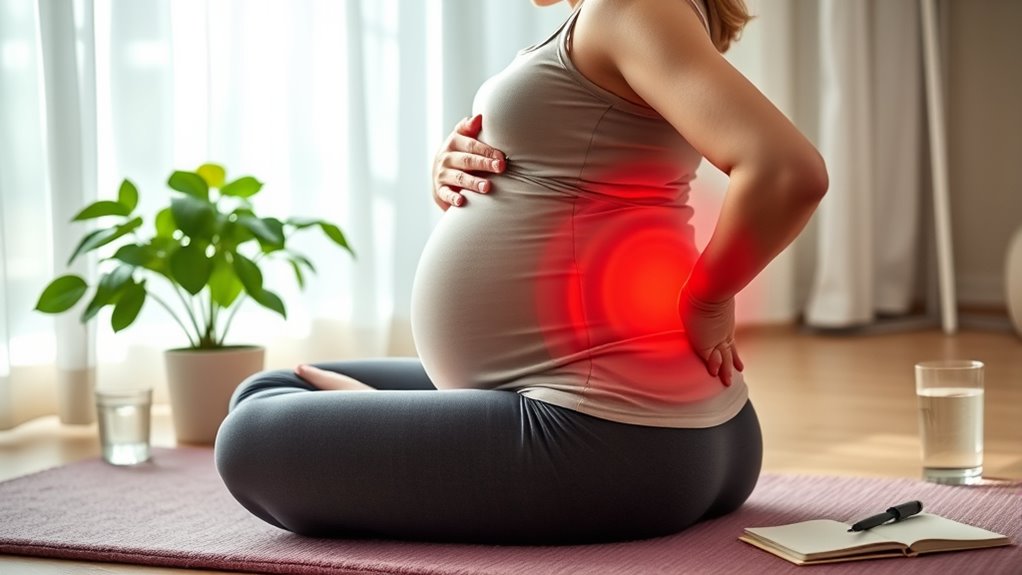If you’re struggling with pelvic pain during pregnancy, try using supportive devices like maternity belts to alleviate discomfort. Engage in physical therapy and targeted exercises to strengthen your pelvic region. Pay attention to your posture, and consider sleeping on your left side with pillows for added comfort. Remember to take breaks, balance rest and activity, and listen to your body. There are more strategies and insights available to help manage your pain effectively.
Key Takeaways
- Use supportive devices like maternity belts to alleviate pressure on the pelvic area.
- Engage in physical therapy and targeted exercises to strengthen the pelvic region.
- Maintain proper posture and switch sleeping positions, ideally on the left side with pillows for added comfort.
- Apply heat or ice therapy to reduce pain and inflammation temporarily.
- Consult a healthcare provider for personalized advice and to address any concerning symptoms.

Pregnancy can bring a host of physical changes, and for many women, pelvic pain is one of the most common challenges faced. Nearly half of pregnant women experience this discomfort, with incidence rates ranging from 48% to 56%. The causes are often linked to hormonal changes, weight gain, and joint instability, all of which can lead to conditions like pelvic girdle pain (PGP) and symphysis pubis dysfunction (SPD).
As your pregnancy progresses, you may notice pain radiating from your lower back to your hips, thighs, and pubic area, making daily activities more difficult.
Managing pelvic pain is crucial for your comfort and well-being. One effective strategy is to use supportive devices like maternity belts, which can help stabilize your pelvis and alleviate discomfort. Physical therapy, too, can be immensely beneficial. By engaging in targeted exercises, you can strengthen your pelvic area and improve your overall mobility.
Managing pelvic pain effectively is vital; consider using maternity belts and physical therapy for relief and improved mobility.
It’s essential to maintain proper posture, which can reduce strain on your pelvis. You might find that sleeping on your left side with pillows between your knees provides added comfort, allowing you to rest more peacefully.
In your daily routine, being mindful of body mechanics is key. When you bend or lift, use your legs instead of your back to prevent exacerbating any discomfort. Balancing rest and activity is also crucial; don’t hesitate to take breaks when you need them. Regularly changing positions can help mitigate the strain on your pelvis and keep you feeling more comfortable throughout the day.
Heat or ice therapy can offer temporary relief as well. Applying a warm compress or an ice pack to the affected area may help alleviate pain and inflammation. However, be sure to listen to your body and consult your healthcare provider if your pain becomes severe or is accompanied by other concerning symptoms like heavy bleeding or fever.
Lastly, don’t hesitate to reach out to your healthcare providers for personalized advice. They can help you navigate your symptoms and recommend additional relief strategies tailored to your needs.
Frequently Asked Questions
Can Pelvic Pain Affect Labor and Delivery?
Yes, pelvic pain can definitely affect labor and delivery. You might experience longer labor durations or a higher likelihood of needing a cesarean section due to severe pain.
Certain positions may feel more comfortable for you during labor, like kneeling or being on all fours. Active labor strategies, such as walking or using a birthing ball, can help manage pain and make your labor experience smoother.
It’s important to explore what works best for you.
Is Pelvic Pain Common During Early Pregnancy?
Yes, pelvic pain is common during early pregnancy. You might notice this discomfort around the 18th week, as your body undergoes significant changes.
It often stems from the stretching and growth of your uterus. While many women experience this type of pain, it can vary in intensity.
Just remember, if your pain is severe or accompanied by other concerning symptoms, it’s always best to consult a healthcare provider for guidance.
How Can I Differentiate Pelvic Pain From Normal Discomfort?
When it comes to pelvic pain, you don’t want to throw caution to the wind.
To differentiate normal discomfort from something more serious, pay attention to the intensity and duration. Mild, fleeting pains are often typical, but if you’re experiencing persistent, severe pain or any unusual symptoms like bleeding or fever, it’s time to seek medical advice.
Always listen to your body; it knows best when something’s off.
Are There Specific Exercises to Avoid During Pelvic Pain?
When dealing with pelvic pain, you should avoid high-impact activities like running or jumping, as they can worsen your discomfort.
Steer clear of single-leg moves, such as lunges or step-ups, since they put uneven strain on your pelvis.
Impact movements and wide leg positions should also be avoided to prevent aggravating pain.
Instead, focus on gentle exercises that promote flexibility and strength without putting excess pressure on your pelvic area.
When Should I Seek Medical Attention for Pelvic Pain?
If you’re experiencing pelvic pain, you should seek medical attention if you notice fever or chills, vaginal bleeding, fainting, or severe pain.
Difficulty moving, fluid leaking from the vagina, reduced fetal movement, or blood in bowel movements are also serious signs.
Don’t hesitate to report nausea, vomiting, or repeated diarrhea that accompanies your pain.
Early intervention can help address any underlying issues and ensure your health and wellbeing are prioritized.
Conclusion
In the grand journey of pregnancy, pelvic pain might feel like an unwelcome companion. But remember, just as Odysseus navigated his trials, you too can find relief. Embrace gentle stretches, warm baths, and supportive pillows as your allies in this quest. Each small step you take brings you closer to comfort and ease. So, don’t let discomfort overshadow the joy of creating new life; instead, let it be a stepping stone on your remarkable adventure.








